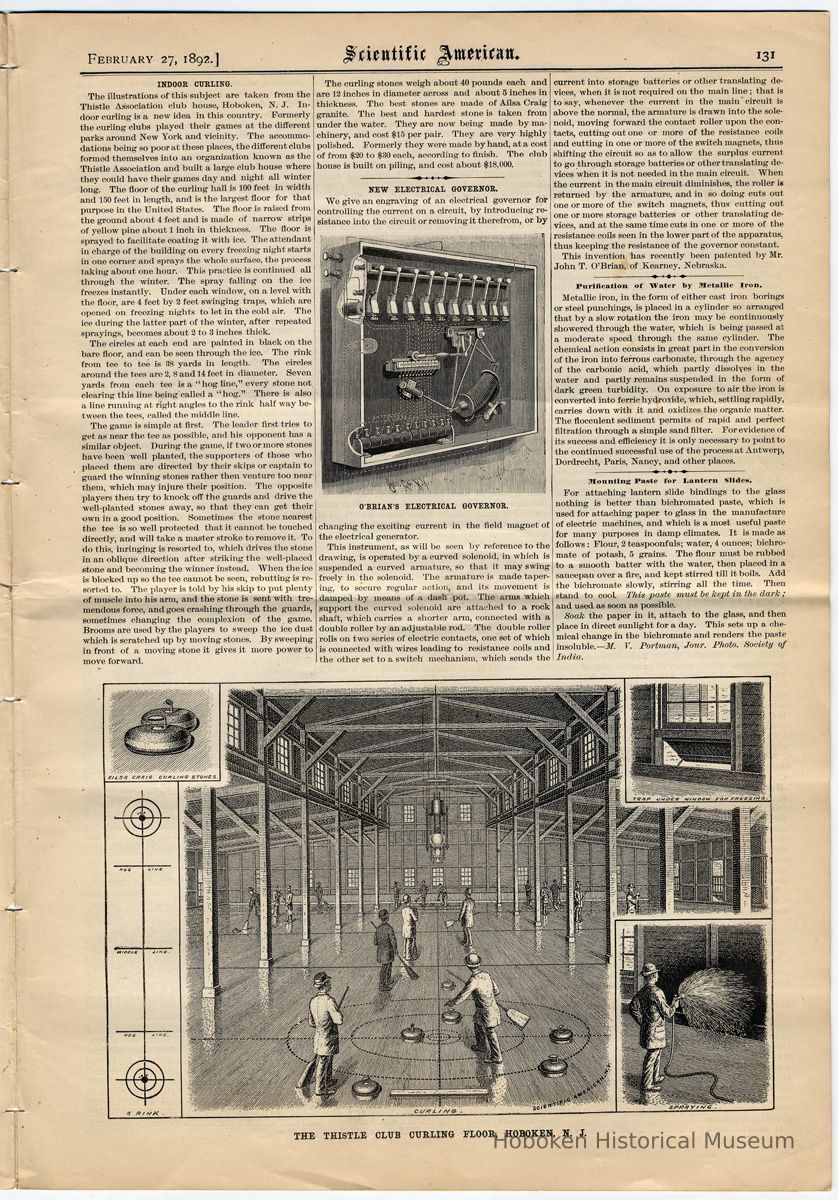Article: Indoor Curling. (Thistle Association club house); Scientific American, Vol. LXVI, No. 9, Feb. 27, 1892.
2012.001.0125
2012.001
Purchase
Purchase
Museum Collections.
1892 - 1892
Date(s) Created: 1892 Date(s): 1892
Notes: February 27, 1892. Scientific American 131 INDOOR CURLING. The illustrations of this subject are taken from the Thistle Association club house, Hoboken. Indoor curling is a new idea in this country. Formerly the curling clubs played their games at the different parks around New York and vicinity. The accommodations being so poor at these places, the different clubs formed themselves into an organization known as the Thistle Association and built a large club house where they could have their games day and night all winter long. The floor of the curling hall is 100 feet in width and 150 feet in length, and is the largest floor for that purpose in the United States. The floor is raised from the ground about 4 feet and is made of narrow strips of yellow pine about 1 inch in thickness. The floor is sprayed to facilitate coating it with ice. The attendant in charge of the building on every freezing night starts in one corner and sprays the whole surface, the process taking about one hour. This practice is continued all through the winter. The spray falling on the ice freezes instantly. Under each window, on a level with the floor, are 4 feet by 2 feet swinging traps, which are opened on freezing nights to let in the cold air. The ice during the latter part of the winter, after repeated sprayings, becomes about 2 to 3 inches thick. The circles at each end are painted in black on the bare floor, and can be seen through the ice. The rink from tee to tee is 38 yards in length. The circles around the tees are 2, 8 and 14 feet in diameter. Seven yards from each tee is a "hog line," every stone not clearing this line being called a "hog." There is also a line running at right angles to the rink half way between the tees, called the middle line. The game is simple at first. The leader first tries to get as near the tee as possible, and his opponent has a similar object. During the game, if two or more stones have been well planted, the supporters of those who placed them are directed by their skips or captain to guard the winning stories rather then venture too near them, which may injure their position. The opposite players then try to knock off the guards and drive the well-planted stones away, so that they can get their own in a good position. Sometimes the stone nearest the tee is so well protected that it cannot be touched directly, and will take a master stroke to remove it. To do this, inringing is resorted to, which drives the stone in an oblique direction after striking the well-placed stone and becoming the winner instead. When the ice is blocked up so the tee cannot be seen, rebutting is resorted to. The player is told by his skip to put plenty of muscle into his arm, and the stone is sent with tremendous force, and goes crashing through the guards, sometimes changing the complexion of the game. Brooms are used by the players to sweep the ice dust which is scratched up by moving stones. By sweeping in front of a moving stone it gives it more power to move forward. The curling stones weigh about 40 pounds each and are 12 inches in diameter across and about 5 inches in thickness. The best stones are made of Ailsa Craig granite. The best and hardest stone is taken from under the water. They are now being made by machinery, and cost $15 per pair. They are very highly polished. Formerly they were made by hand, at a cost of from $20 to $30 each, according to finish. The club house is built on piling, and cost about $18,000. ==== Status: OK Status By: dw Status Date: 2012-08-21




